FRP Characterization: Raman Spectroscopy, PL, and AFM Techniques
VerifiedAdded on 2023/06/11
|15
|1611
|409
Report
AI Summary
This report critically evaluates the application of Raman spectroscopy, photoluminescence (PL), and Atomic Force Microscopy (AFM) techniques for characterizing Fiber Reinforced Plastic (FRP). It justifies the appropriateness of these techniques, highlighting their advantages such as non-destructive analysis, high resolution, and suitability for composite materials, while also addressing limitations like sensitivity challenges, slow scanning times, and potential difficulties with certain sample types. Improvements and opportunities for enhancing these techniques, such as increasing probe sizes and improving compatibility, are discussed. The report concludes that material characterization is essential for ensuring the quality and durability of materials in various sectors, emphasizing the importance of selecting appropriate techniques based on the specific material properties and research objectives. Desklib provides access to this assignment and other study resources for students.
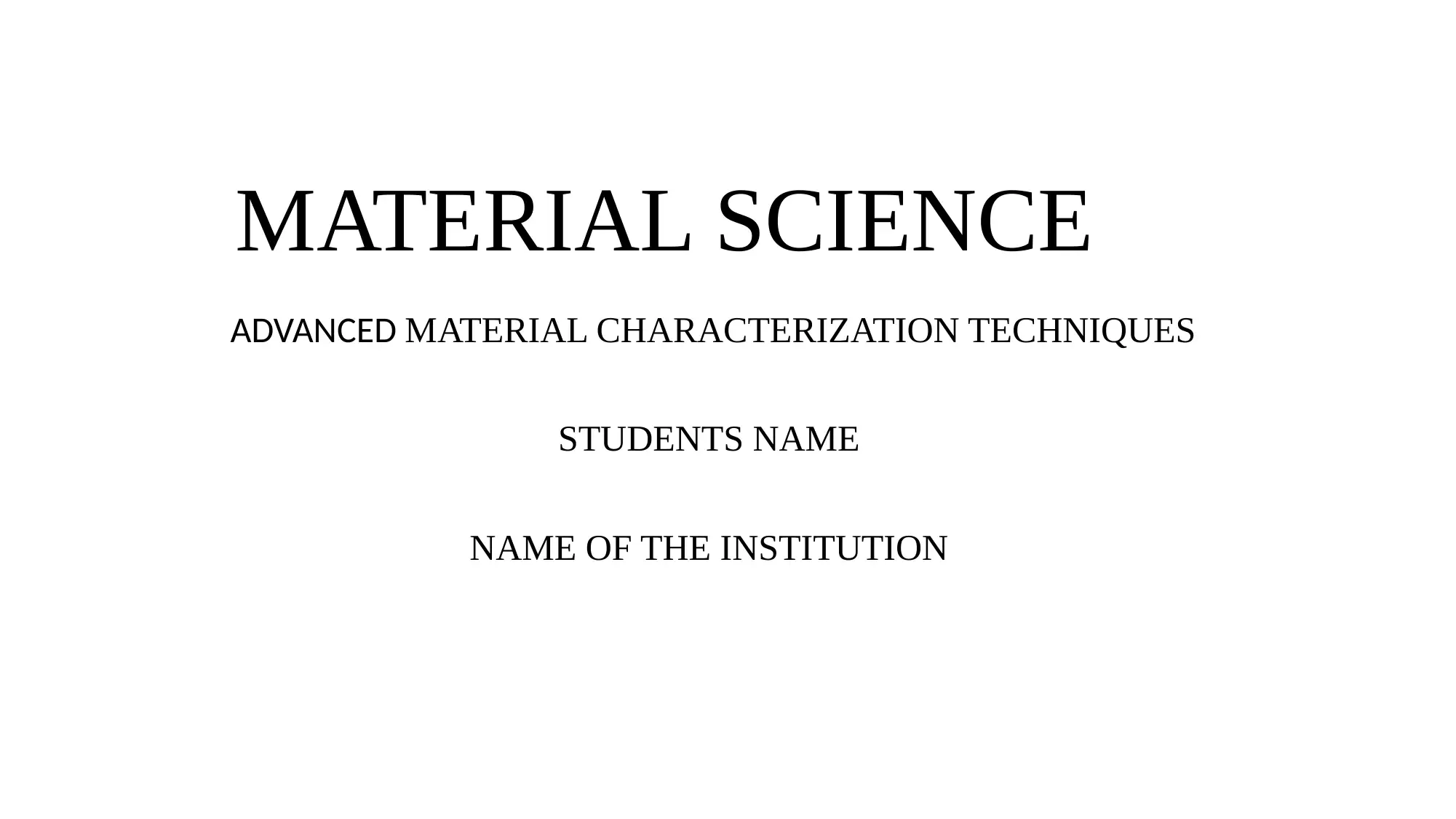
MATERIAL SCIENCE
ADVANCED MATERIAL CHARACTERIZATION TECHNIQUES
STUDENTS NAME
NAME OF THE INSTITUTION
ADVANCED MATERIAL CHARACTERIZATION TECHNIQUES
STUDENTS NAME
NAME OF THE INSTITUTION
Paraphrase This Document
Need a fresh take? Get an instant paraphrase of this document with our AI Paraphraser
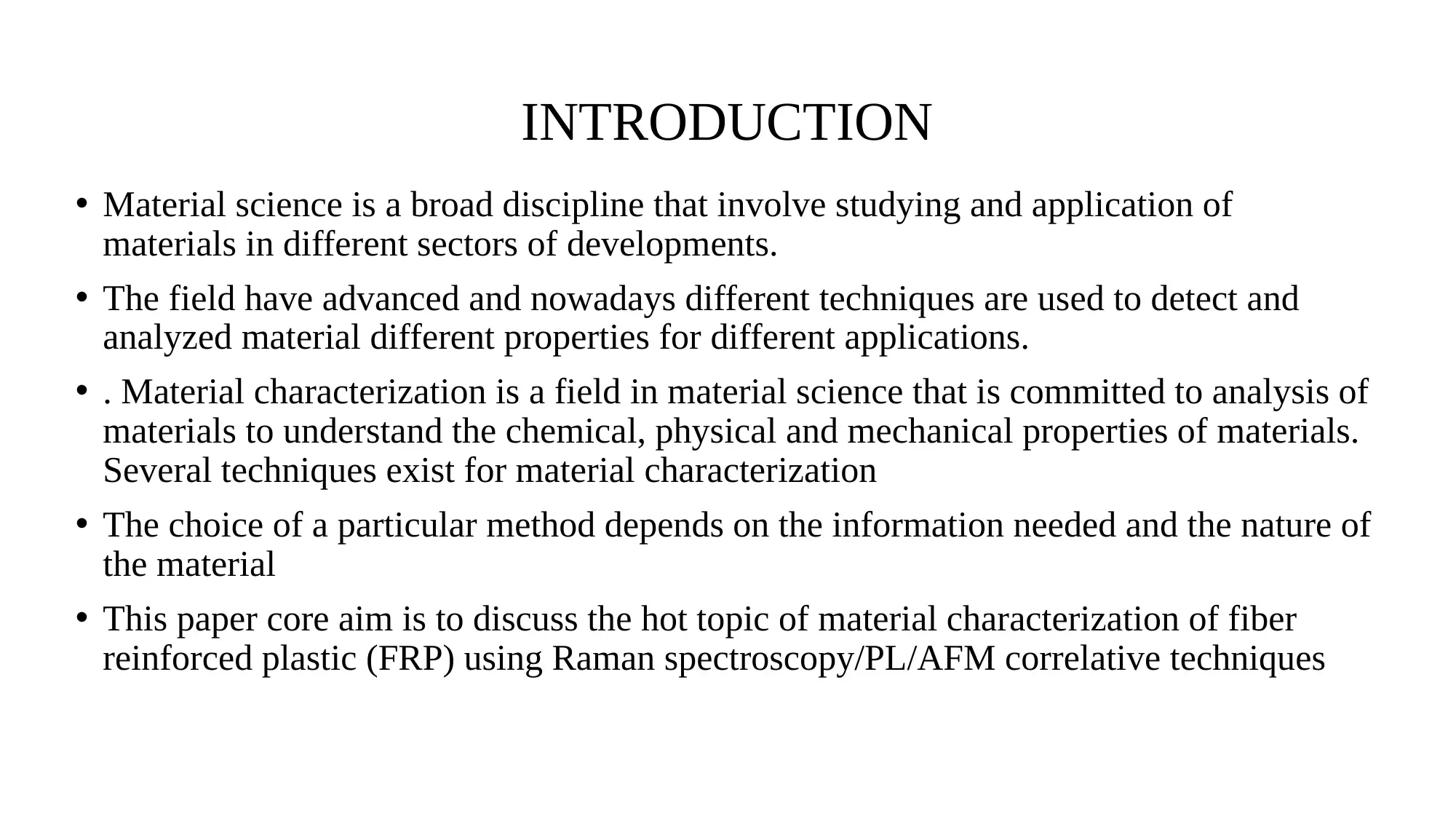
INTRODUCTION
• Material science is a broad discipline that involve studying and application of
materials in different sectors of developments.
• The field have advanced and nowadays different techniques are used to detect and
analyzed material different properties for different applications.
• . Material characterization is a field in material science that is committed to analysis of
materials to understand the chemical, physical and mechanical properties of materials.
Several techniques exist for material characterization
• The choice of a particular method depends on the information needed and the nature of
the material
• This paper core aim is to discuss the hot topic of material characterization of fiber
reinforced plastic (FRP) using Raman spectroscopy/PL/AFM correlative techniques
• Material science is a broad discipline that involve studying and application of
materials in different sectors of developments.
• The field have advanced and nowadays different techniques are used to detect and
analyzed material different properties for different applications.
• . Material characterization is a field in material science that is committed to analysis of
materials to understand the chemical, physical and mechanical properties of materials.
Several techniques exist for material characterization
• The choice of a particular method depends on the information needed and the nature of
the material
• This paper core aim is to discuss the hot topic of material characterization of fiber
reinforced plastic (FRP) using Raman spectroscopy/PL/AFM correlative techniques
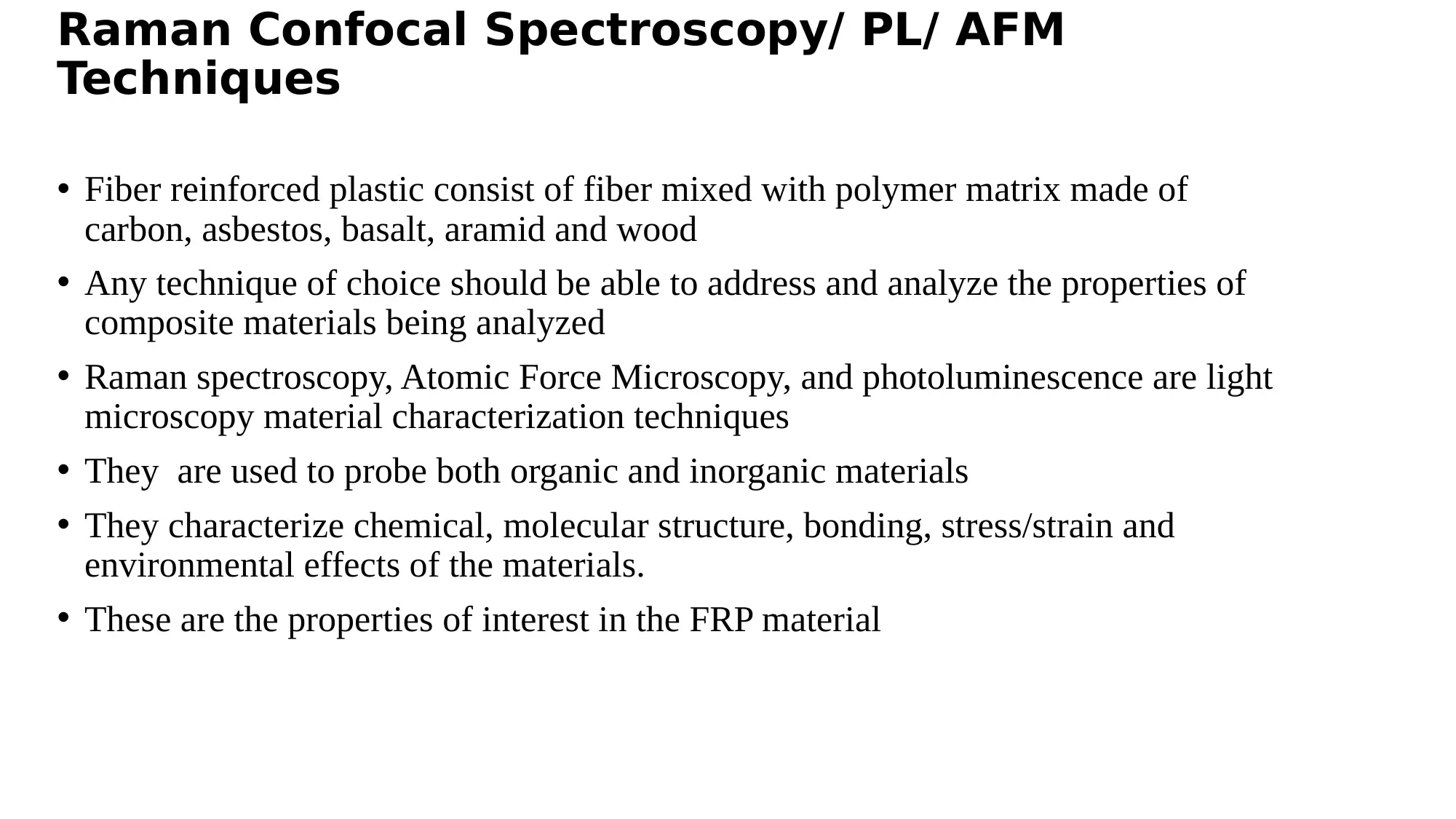
Raman Confocal Spectroscopy/ PL/ AFM
Techniques
• Fiber reinforced plastic consist of fiber mixed with polymer matrix made of
carbon, asbestos, basalt, aramid and wood
• Any technique of choice should be able to address and analyze the properties of
composite materials being analyzed
• Raman spectroscopy, Atomic Force Microscopy, and photoluminescence are light
microscopy material characterization techniques
• They are used to probe both organic and inorganic materials
• They characterize chemical, molecular structure, bonding, stress/strain and
environmental effects of the materials.
• These are the properties of interest in the FRP material
Techniques
• Fiber reinforced plastic consist of fiber mixed with polymer matrix made of
carbon, asbestos, basalt, aramid and wood
• Any technique of choice should be able to address and analyze the properties of
composite materials being analyzed
• Raman spectroscopy, Atomic Force Microscopy, and photoluminescence are light
microscopy material characterization techniques
• They are used to probe both organic and inorganic materials
• They characterize chemical, molecular structure, bonding, stress/strain and
environmental effects of the materials.
• These are the properties of interest in the FRP material
⊘ This is a preview!⊘
Do you want full access?
Subscribe today to unlock all pages.

Trusted by 1+ million students worldwide
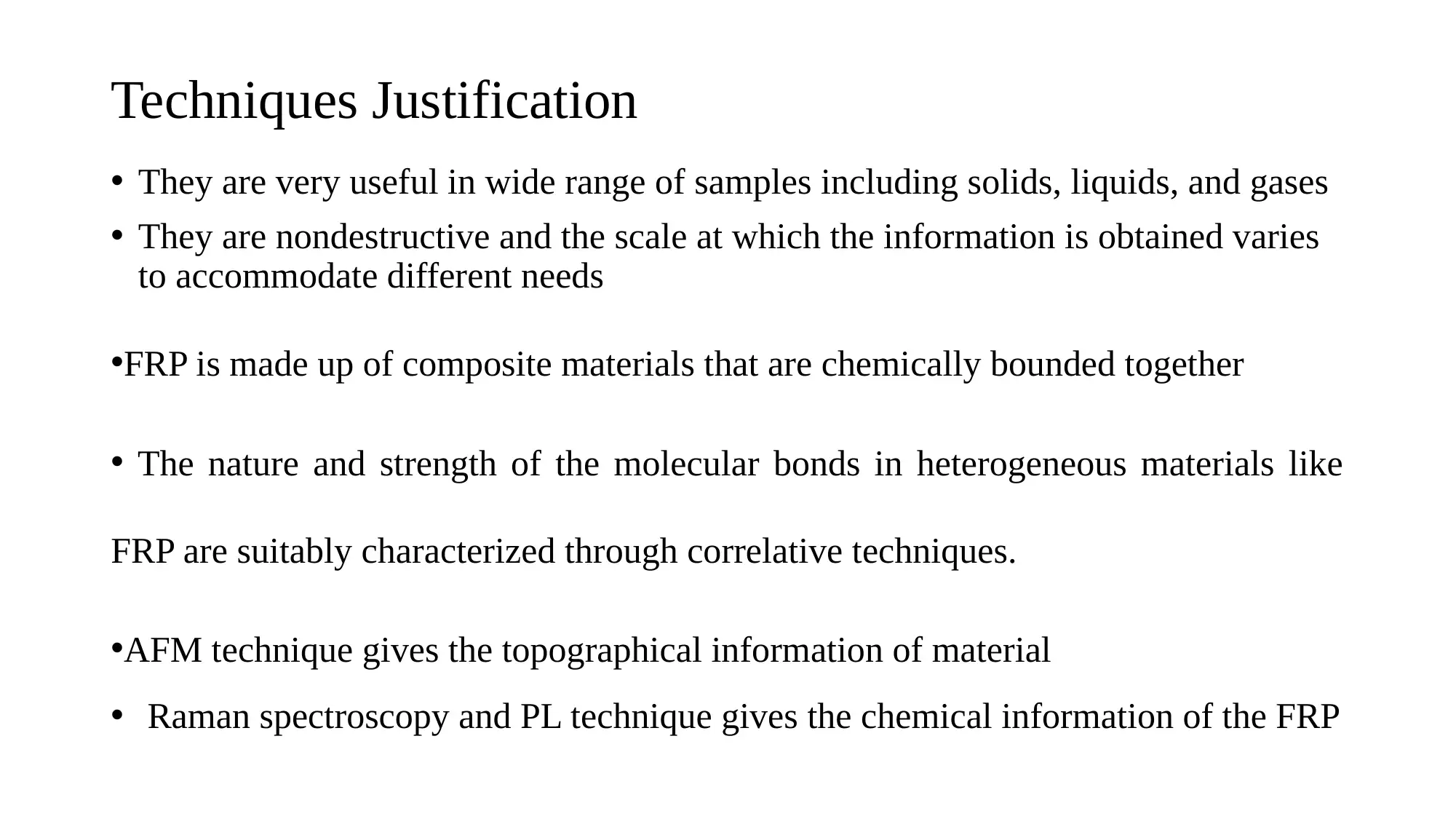
Techniques Justification
• They are very useful in wide range of samples including solids, liquids, and gases
• They are nondestructive and the scale at which the information is obtained varies
to accommodate different needs
•FRP is made up of composite materials that are chemically bounded together
• The nature and strength of the molecular bonds in heterogeneous materials like
FRP are suitably characterized through correlative techniques.
•AFM technique gives the topographical information of material
• Raman spectroscopy and PL technique gives the chemical information of the FRP
• They are very useful in wide range of samples including solids, liquids, and gases
• They are nondestructive and the scale at which the information is obtained varies
to accommodate different needs
•FRP is made up of composite materials that are chemically bounded together
• The nature and strength of the molecular bonds in heterogeneous materials like
FRP are suitably characterized through correlative techniques.
•AFM technique gives the topographical information of material
• Raman spectroscopy and PL technique gives the chemical information of the FRP
Paraphrase This Document
Need a fresh take? Get an instant paraphrase of this document with our AI Paraphraser
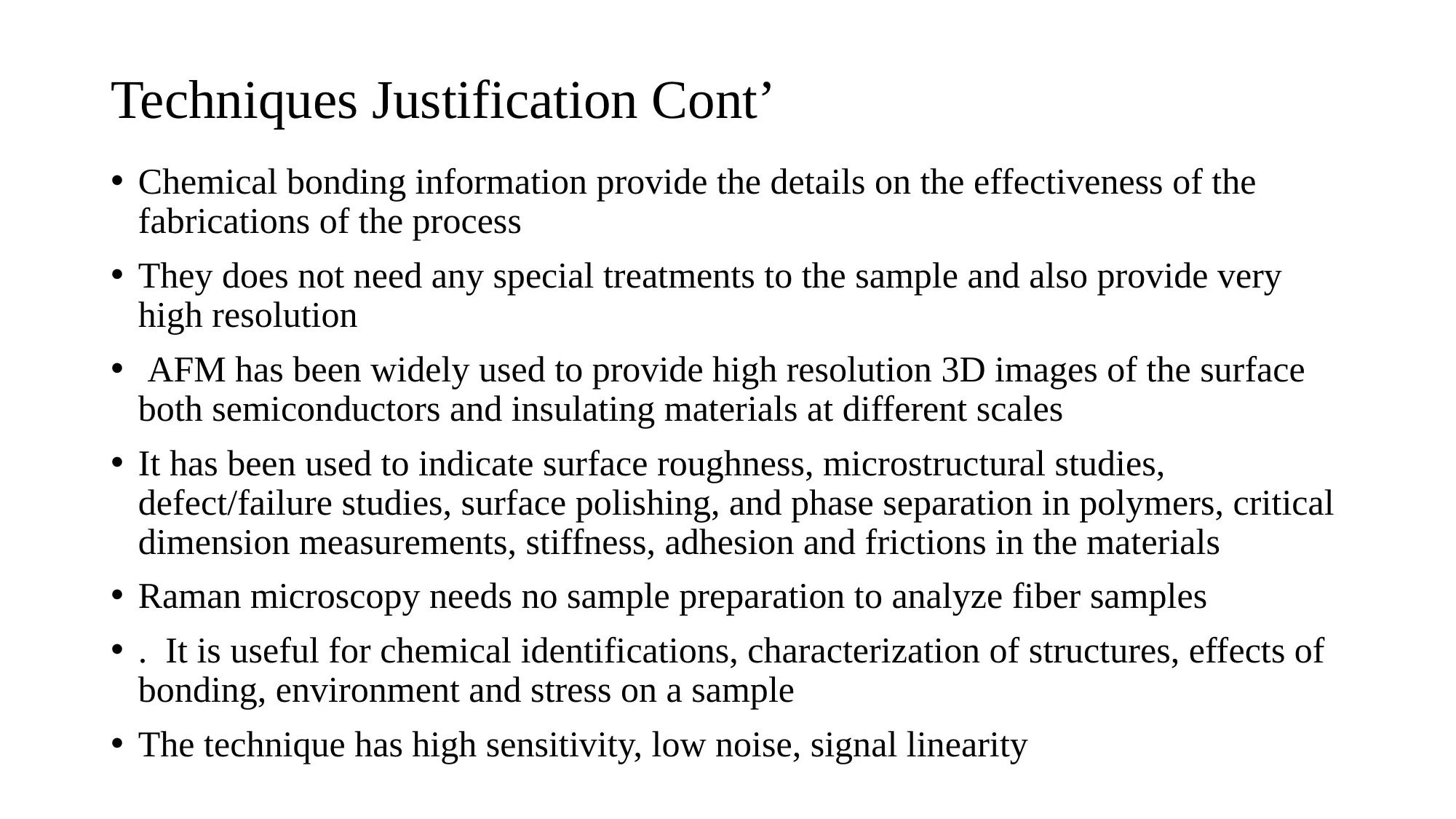
Techniques Justification Cont’
• Chemical bonding information provide the details on the effectiveness of the
fabrications of the process
• They does not need any special treatments to the sample and also provide very
high resolution
• AFM has been widely used to provide high resolution 3D images of the surface
both semiconductors and insulating materials at different scales
• It has been used to indicate surface roughness, microstructural studies,
defect/failure studies, surface polishing, and phase separation in polymers, critical
dimension measurements, stiffness, adhesion and frictions in the materials
• Raman microscopy needs no sample preparation to analyze fiber samples
• . It is useful for chemical identifications, characterization of structures, effects of
bonding, environment and stress on a sample
• The technique has high sensitivity, low noise, signal linearity
• Chemical bonding information provide the details on the effectiveness of the
fabrications of the process
• They does not need any special treatments to the sample and also provide very
high resolution
• AFM has been widely used to provide high resolution 3D images of the surface
both semiconductors and insulating materials at different scales
• It has been used to indicate surface roughness, microstructural studies,
defect/failure studies, surface polishing, and phase separation in polymers, critical
dimension measurements, stiffness, adhesion and frictions in the materials
• Raman microscopy needs no sample preparation to analyze fiber samples
• . It is useful for chemical identifications, characterization of structures, effects of
bonding, environment and stress on a sample
• The technique has high sensitivity, low noise, signal linearity
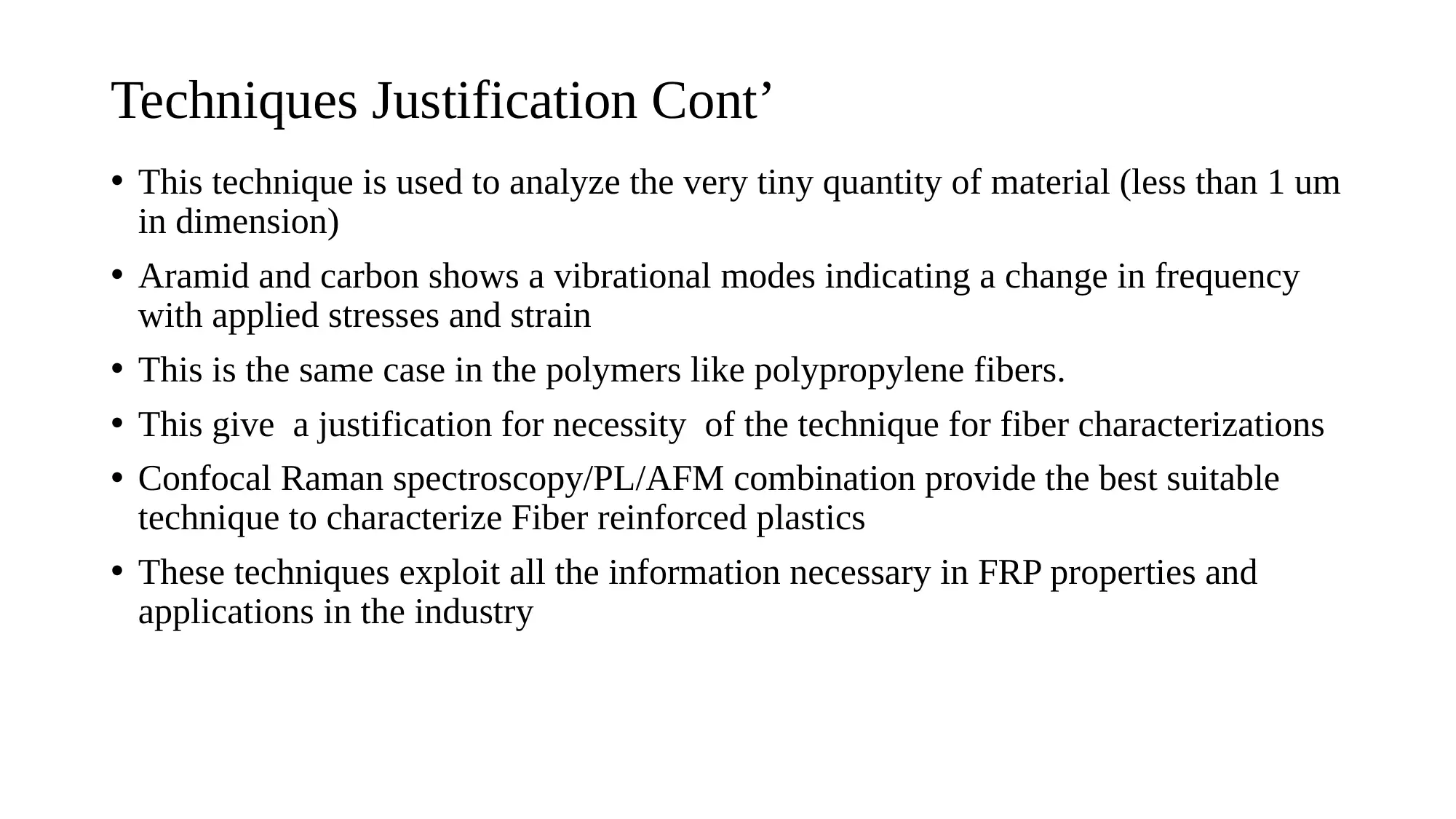
Techniques Justification Cont’
• This technique is used to analyze the very tiny quantity of material (less than 1 um
in dimension)
• Aramid and carbon shows a vibrational modes indicating a change in frequency
with applied stresses and strain
• This is the same case in the polymers like polypropylene fibers.
• This give a justification for necessity of the technique for fiber characterizations
• Confocal Raman spectroscopy/PL/AFM combination provide the best suitable
technique to characterize Fiber reinforced plastics
• These techniques exploit all the information necessary in FRP properties and
applications in the industry
• This technique is used to analyze the very tiny quantity of material (less than 1 um
in dimension)
• Aramid and carbon shows a vibrational modes indicating a change in frequency
with applied stresses and strain
• This is the same case in the polymers like polypropylene fibers.
• This give a justification for necessity of the technique for fiber characterizations
• Confocal Raman spectroscopy/PL/AFM combination provide the best suitable
technique to characterize Fiber reinforced plastics
• These techniques exploit all the information necessary in FRP properties and
applications in the industry
⊘ This is a preview!⊘
Do you want full access?
Subscribe today to unlock all pages.

Trusted by 1+ million students worldwide
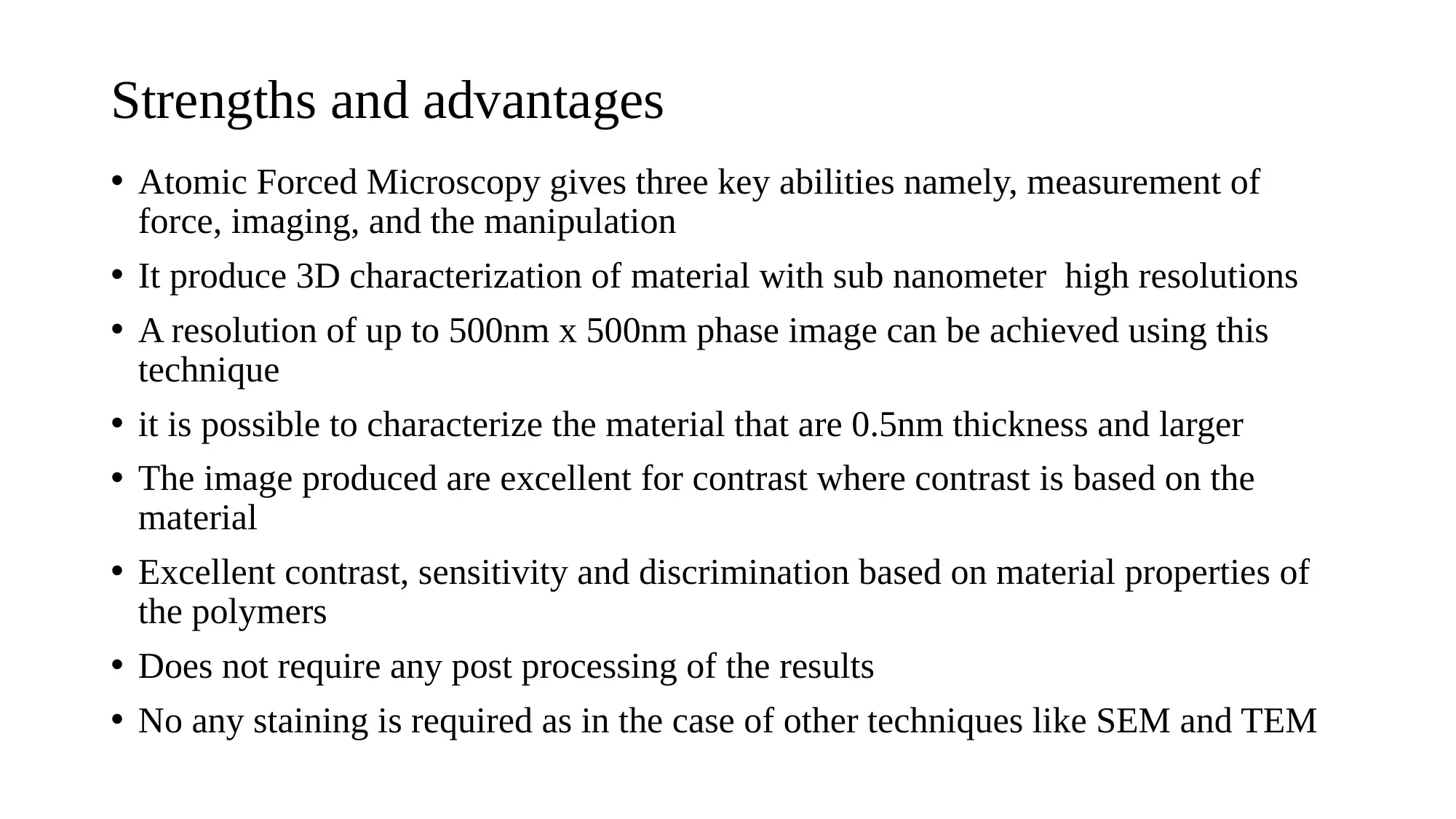
Strengths and advantages
• Atomic Forced Microscopy gives three key abilities namely, measurement of
force, imaging, and the manipulation
• It produce 3D characterization of material with sub nanometer high resolutions
• A resolution of up to 500nm x 500nm phase image can be achieved using this
technique
• it is possible to characterize the material that are 0.5nm thickness and larger
• The image produced are excellent for contrast where contrast is based on the
material
• Excellent contrast, sensitivity and discrimination based on material properties of
the polymers
• Does not require any post processing of the results
• No any staining is required as in the case of other techniques like SEM and TEM
• Atomic Forced Microscopy gives three key abilities namely, measurement of
force, imaging, and the manipulation
• It produce 3D characterization of material with sub nanometer high resolutions
• A resolution of up to 500nm x 500nm phase image can be achieved using this
technique
• it is possible to characterize the material that are 0.5nm thickness and larger
• The image produced are excellent for contrast where contrast is based on the
material
• Excellent contrast, sensitivity and discrimination based on material properties of
the polymers
• Does not require any post processing of the results
• No any staining is required as in the case of other techniques like SEM and TEM
Paraphrase This Document
Need a fresh take? Get an instant paraphrase of this document with our AI Paraphraser
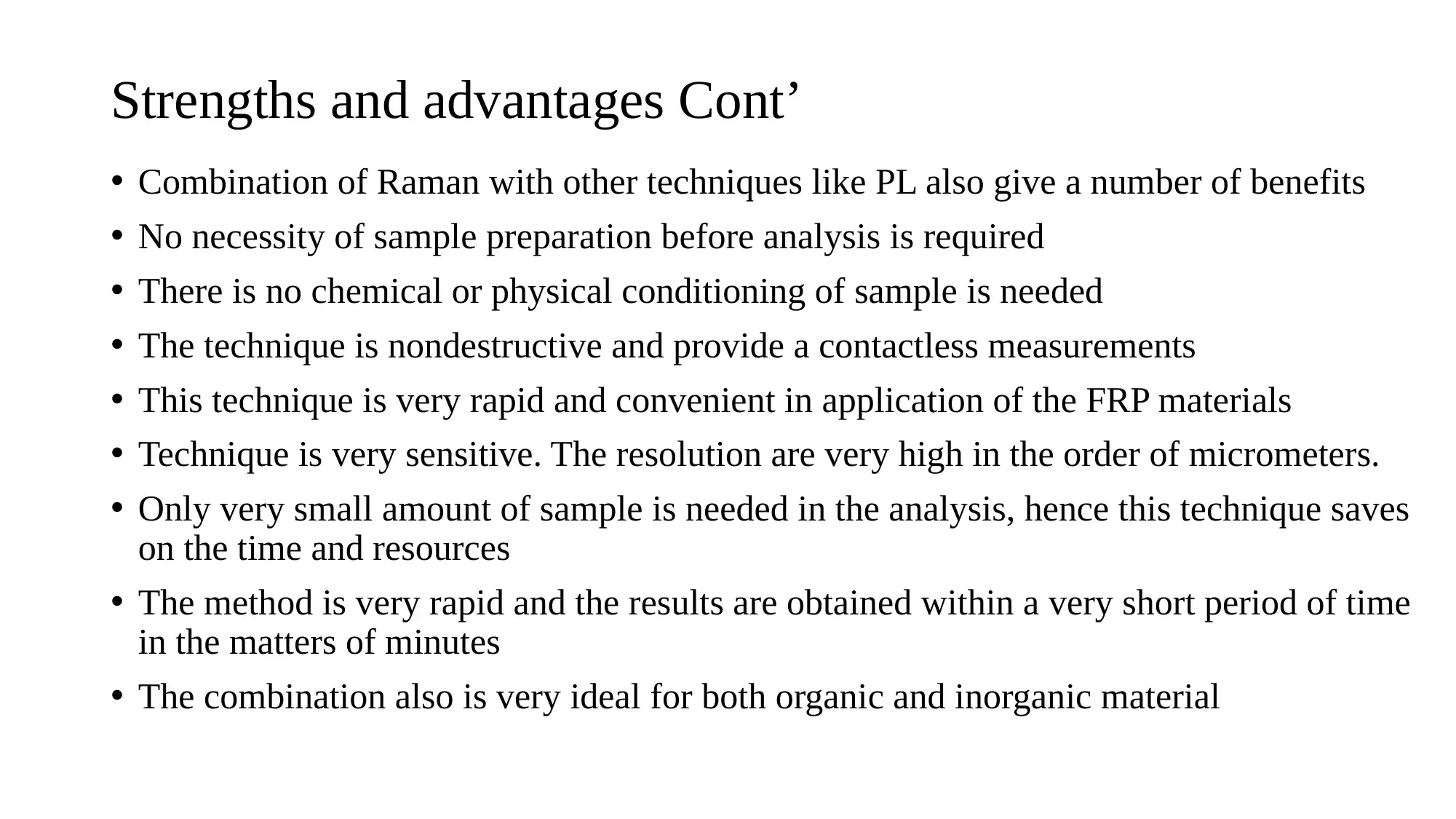
Strengths and advantages Cont’
• Combination of Raman with other techniques like PL also give a number of benefits
• No necessity of sample preparation before analysis is required
• There is no chemical or physical conditioning of sample is needed
• The technique is nondestructive and provide a contactless measurements
• This technique is very rapid and convenient in application of the FRP materials
• Technique is very sensitive. The resolution are very high in the order of micrometers.
• Only very small amount of sample is needed in the analysis, hence this technique saves
on the time and resources
• The method is very rapid and the results are obtained within a very short period of time
in the matters of minutes
• The combination also is very ideal for both organic and inorganic material
• Combination of Raman with other techniques like PL also give a number of benefits
• No necessity of sample preparation before analysis is required
• There is no chemical or physical conditioning of sample is needed
• The technique is nondestructive and provide a contactless measurements
• This technique is very rapid and convenient in application of the FRP materials
• Technique is very sensitive. The resolution are very high in the order of micrometers.
• Only very small amount of sample is needed in the analysis, hence this technique saves
on the time and resources
• The method is very rapid and the results are obtained within a very short period of time
in the matters of minutes
• The combination also is very ideal for both organic and inorganic material
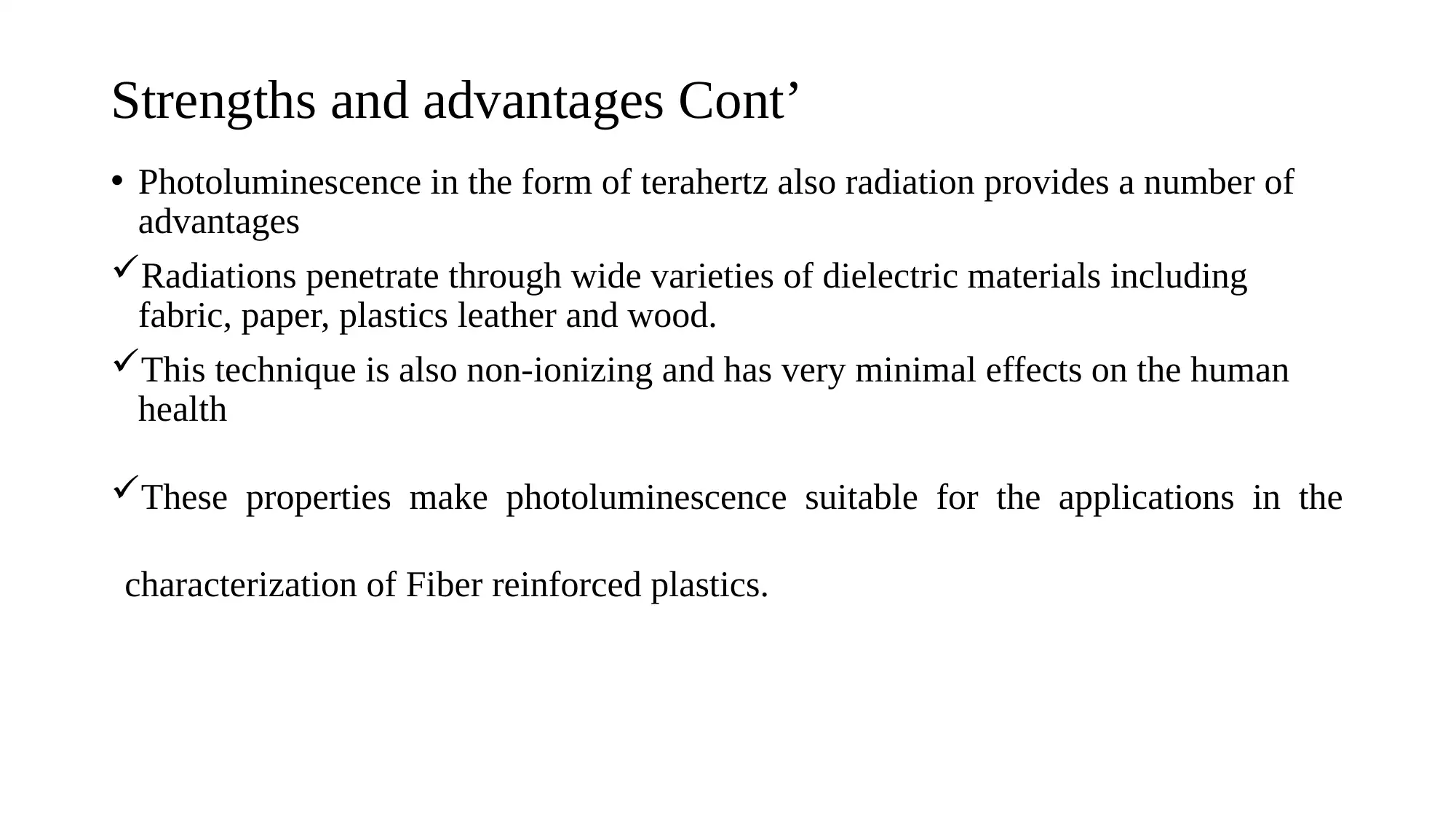
Strengths and advantages Cont’
• Photoluminescence in the form of terahertz also radiation provides a number of
advantages
Radiations penetrate through wide varieties of dielectric materials including
fabric, paper, plastics leather and wood.
This technique is also non-ionizing and has very minimal effects on the human
health
These properties make photoluminescence suitable for the applications in the
characterization of Fiber reinforced plastics.
• Photoluminescence in the form of terahertz also radiation provides a number of
advantages
Radiations penetrate through wide varieties of dielectric materials including
fabric, paper, plastics leather and wood.
This technique is also non-ionizing and has very minimal effects on the human
health
These properties make photoluminescence suitable for the applications in the
characterization of Fiber reinforced plastics.
⊘ This is a preview!⊘
Do you want full access?
Subscribe today to unlock all pages.

Trusted by 1+ million students worldwide
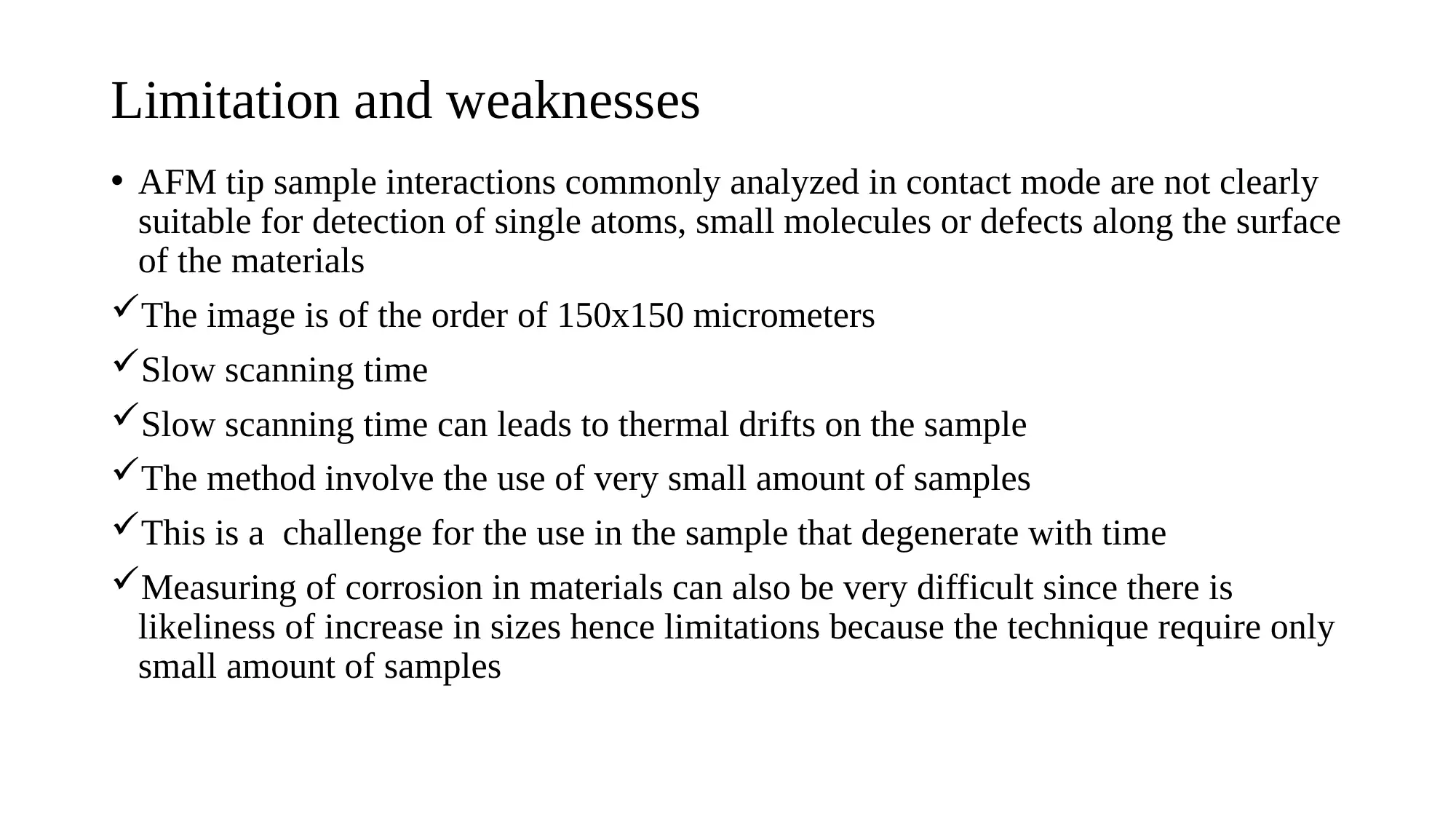
Limitation and weaknesses
• AFM tip sample interactions commonly analyzed in contact mode are not clearly
suitable for detection of single atoms, small molecules or defects along the surface
of the materials
The image is of the order of 150x150 micrometers
Slow scanning time
Slow scanning time can leads to thermal drifts on the sample
The method involve the use of very small amount of samples
This is a challenge for the use in the sample that degenerate with time
Measuring of corrosion in materials can also be very difficult since there is
likeliness of increase in sizes hence limitations because the technique require only
small amount of samples
• AFM tip sample interactions commonly analyzed in contact mode are not clearly
suitable for detection of single atoms, small molecules or defects along the surface
of the materials
The image is of the order of 150x150 micrometers
Slow scanning time
Slow scanning time can leads to thermal drifts on the sample
The method involve the use of very small amount of samples
This is a challenge for the use in the sample that degenerate with time
Measuring of corrosion in materials can also be very difficult since there is
likeliness of increase in sizes hence limitations because the technique require only
small amount of samples
Paraphrase This Document
Need a fresh take? Get an instant paraphrase of this document with our AI Paraphraser
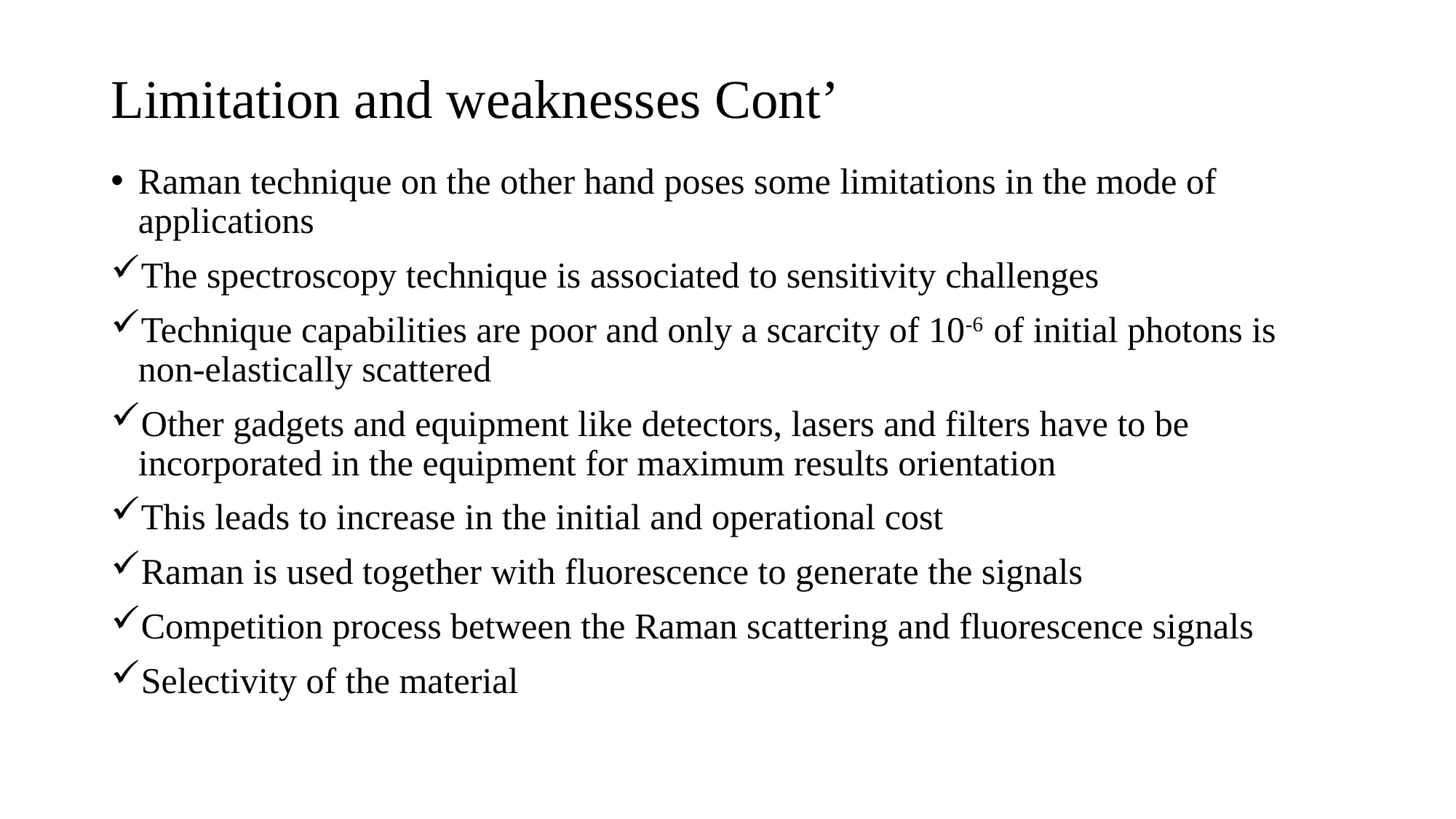
Limitation and weaknesses Cont’
• Raman technique on the other hand poses some limitations in the mode of
applications
The spectroscopy technique is associated to sensitivity challenges
Technique capabilities are poor and only a scarcity of 10-6 of initial photons is
non-elastically scattered
Other gadgets and equipment like detectors, lasers and filters have to be
incorporated in the equipment for maximum results orientation
This leads to increase in the initial and operational cost
Raman is used together with fluorescence to generate the signals
Competition process between the Raman scattering and fluorescence signals
Selectivity of the material
• Raman technique on the other hand poses some limitations in the mode of
applications
The spectroscopy technique is associated to sensitivity challenges
Technique capabilities are poor and only a scarcity of 10-6 of initial photons is
non-elastically scattered
Other gadgets and equipment like detectors, lasers and filters have to be
incorporated in the equipment for maximum results orientation
This leads to increase in the initial and operational cost
Raman is used together with fluorescence to generate the signals
Competition process between the Raman scattering and fluorescence signals
Selectivity of the material
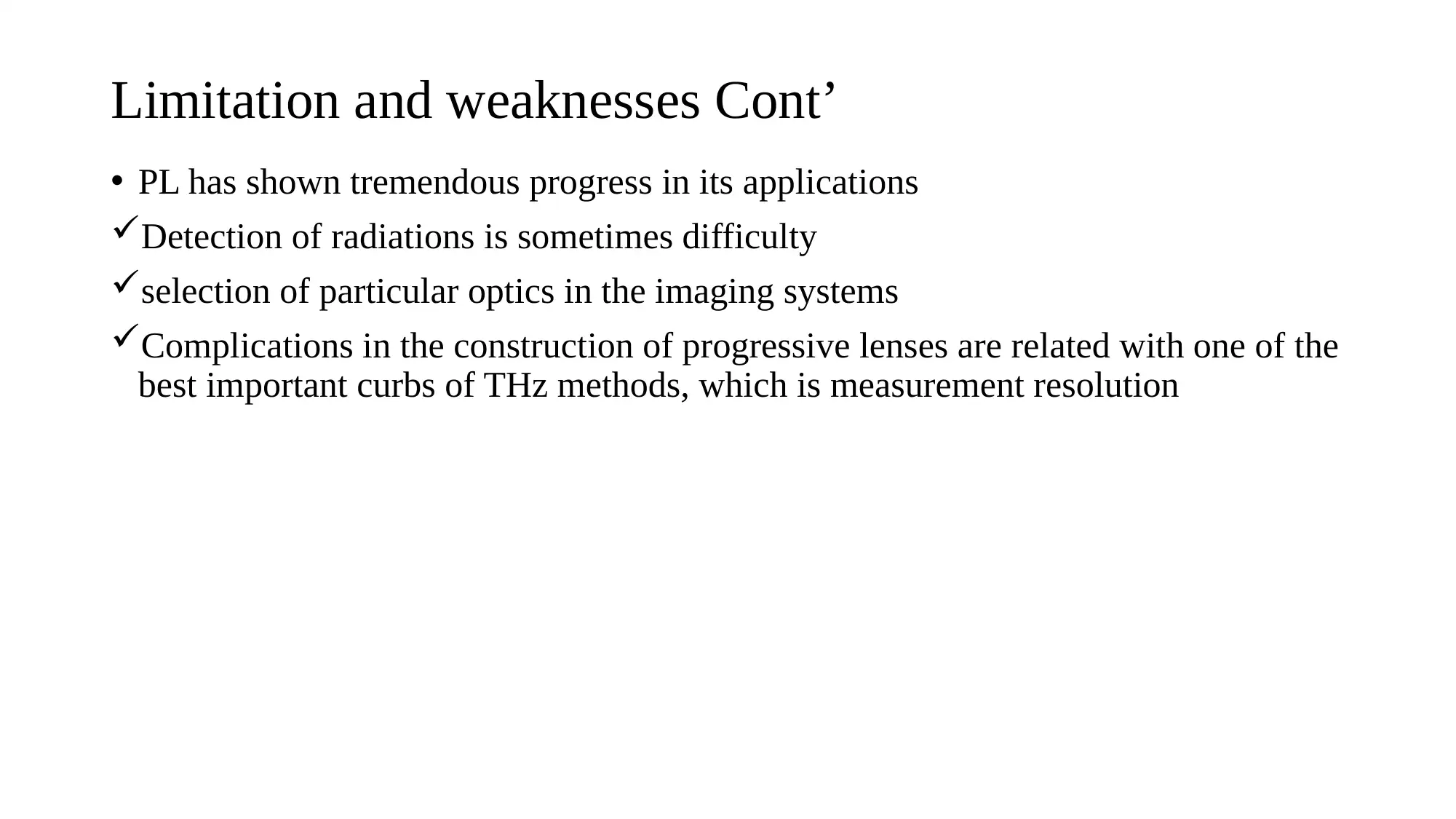
Limitation and weaknesses Cont’
• PL has shown tremendous progress in its applications
Detection of radiations is sometimes difficulty
selection of particular optics in the imaging systems
Complications in the construction of progressive lenses are related with one of the
best important curbs of THz methods, which is measurement resolution
• PL has shown tremendous progress in its applications
Detection of radiations is sometimes difficulty
selection of particular optics in the imaging systems
Complications in the construction of progressive lenses are related with one of the
best important curbs of THz methods, which is measurement resolution
⊘ This is a preview!⊘
Do you want full access?
Subscribe today to unlock all pages.

Trusted by 1+ million students worldwide
1 out of 15
Your All-in-One AI-Powered Toolkit for Academic Success.
+13062052269
info@desklib.com
Available 24*7 on WhatsApp / Email
![[object Object]](/_next/static/media/star-bottom.7253800d.svg)
Unlock your academic potential
Copyright © 2020–2025 A2Z Services. All Rights Reserved. Developed and managed by ZUCOL.
